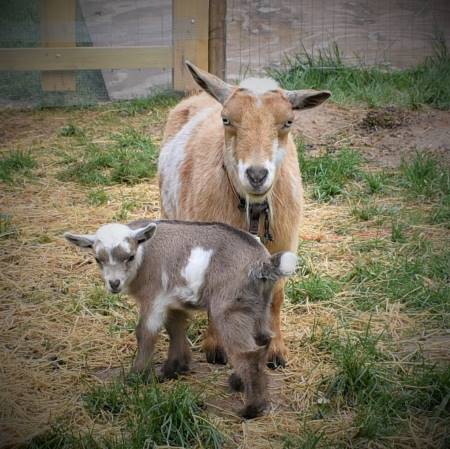Pregnancy Toxaemia
Pregnancy Toxaemia
by: Robert Van Saun, DVM, MS, PhD Department of Veterinary Science Pennsylvania State University
Commonly known as pregnancy disease, pregnancy ketosis or twin lamb/kid disease. Pregnancy toxemia is a metabolic disease of goats and sheep commonly occurring in the last six weeks of gestation in does with multiple fetuses.
A similar syndrome occurs in early lactation in heavily lactating does (see next section). Factors important in the development of the disease are: (1) presence of two or more fetuses; (2) undernourishment during late pregnancy when the fetuses have the most rapid growth and (3) addition of stress such as severe weather, sudden changes in feed or other disease or transportation upon the previous factors.
The mortality rate is high in affected animals. Most information available comes from studies in sheep. Through recognition of early signs and symptoms and avoidance of predisposing factors, pregnancy toxemia can be reduced to a sporadic condition.
Clinical Signs. Disease course varies but generally develops over three to ten days. A more sudden onset is usually associated with a sudden stress or poor producer observation. Appetite is poor or absent, with decreased consumption of grain observed first. Does separate from the herd, lag behind and become depressed and gaunt. Other signs of predisposing disease may also be present. Producers vigilant when hand feeding does will easily recognize these animals.
Clinical signs are those observed with involvement of the central nervous system. Initially, the animal tends to separate from others. There is mild depression. Evidence of blindness develops, the animal runs into objects, shows little or no reaction when approached, and wanders aimlessly. Dullness and depression become progressively severe. There is reluctance to move. Eventually they go down in sternal or lateral recumbency and show little or no response to their environment. The does become comatose and eventually die. Occasionally, animals may show a short period or intermittent periods of hypersensitivity, due possibly to ketone-induced magnesium deficiency. There may be quivering, twitching of the ears, muzzle or eyelids or spasms of certain muscles. Incoordination may be evident. Recumbent animals may have convulsive paddling movements. Chewing, teeth grinding or vigorous licking movements may be seen. Mild scouring may be present. A snuffling respiration due to excessive nasal secretion may be common. Drooling of saliva is also seen. Temperature and pulse are within normal limits. Respiration is usually normal until the later stages when it may become labored. Ketones may be detected in the urine using diagnostic strips or smelled on the breath (sweet acetone smell). Diseases that may look similar to pregnancy toxemia include polioencephalomalacia, hypocalcaemia, toxic mastitis (if near or after kidding), grain overload, listeriosis and lead poisoning.
Causes. The primary cause of pregnancy toxemia is a lack of glucose as an energy source. This results from either poor nutrition, excessive demand from multiple fetuses or some combination. As pregnancy progresses, an increasing demand is on the available blood glucose supply of the doe due to rapid fetal development. The principal source of energy to the fetus is glucose and utilization by the fetus occurs at the detriment of the mother. Glucose requirements during late pregnancy are increased 70-80% over nonpregnant state since more than 60% of fetal growth occurs during the last 40 days of pregnancy. Blood sugar levels decrease as pregnancy progresses (hypoglycemia) from a normal 35-45 mg per 100 ml blood to 20-25 mg per 100 ml blood in late pregnancy. Pregnancy toxemia may develop when levels decrease to about 18 mg per 100 ml blood. The severity of hypoglycemia will be directly affected by undernourishment of the mother or by increased requirements of the fetus(es). As the glucose supply diminishes from increasing fetal demands and decreased glucose production due to undernourishment, energy requirements must be derived from alternative sources. The pregnant does is primarily using body fat for an energy source. Fats can not cross the placenta, and thereby do not provide energy for the developing fetus. Amino acids from proteins can be made into glucose and are a primary source when doe nutrition is inadequate. As the doe breaks down more fat as an energy source, the resultant fatty acids can overwhelm the liver’s capacity to metabolize them. This results in excessive ketone bodies, acetone, acetoacetate and beta-hydroxybutyrate, and fatty infiltration of the liver (fatty liver disease). Fatty infiltration of the liver is recognized on post mortem findings of an enlarged pale yellow to orange colored liver. As ketosis increases, bicarbonate level in the blood decreases and acidosis may result. When the bicarbonate level declines sufficiently, the animal will become comatose. During the later stages of pregnancy toxemia, water consumption decreases, urine output is decreased and kidney function is impaired. The blood sugar level may increase severely (hyperglycemia) during the late stages of the disease as a result of the response of the adrenal glands to stress. Circumstances causing severe hypoglycemia will usually result in pregnancy toxemia. Under-nourishment of the doe may not meet the demands for glucose production. Level of nutrition should be increasing as pregnancy progresses so that the doe will be able to provide fetal requirements. The doe should be gaining weight during pregnancy. A gradual onset of undernourishment, as would be seen if the feed intake was not increased during pregnancy, may be tolerated by the doe and toxemia may not develop. However, if the animal is starved for several days, pregnancy toxemia may develop readily. Sudden changes in weather, infections or transport may result in periods of inappetence and may trigger pregnancy toxemia.
Treatment. The following are the important areas to address in treating pregnancy toxemia. Glucose Replacement. Does in the very early stages of pregnancy toxemia may respond to oral administration of propylene glycol (60 ml twice daily) for at least 3 days. In addition to oral glucose precursors, especially for all does beyond the very early stages of the disease, intravenous glucose administration for 1 or more treatments, depending upon response, will be required. Insulin may be used with these treatments for better utilization of glucose (consult your veterinarian). During later stages of the disease, glucose administration may be ineffective or detrimental because the blood glucose levels may be very high. Address Dehydration, Acid-Base Balance. During the later stages of the disease, acidosis and dehydration may be important factors. Intravenous administration of large volumes of electrolyte solutions with sodium bicarbonate may be important. Corticosteroids may not be effective in the later stages unless given at dosages utilized to combat endotoxic shock. Reducing Glucose Demand. Developing fetuses are inducing the glucose drain on the doe. A decision will need to be made regarding the relative importance of kid versus doe survivability. Abortion is the preferred method as it is more affordable and less stressful to the doe. If the kids are more than 2 to 3 days premature, they will be unlikely to survive but are already at great risk of death in a severely ill doe. Consult your veterinarian about this procedure. Before a caesarian section is performed, the doe should be stabilized using appropriate fluid therapy. This is a disease that needs to be prevented rather than treated. It is generally a management disease and should be initially investigated as a herd level problem rather than an individual sick goat. If one doe is clinically ill, many more in the herd are likely at risk.
Prevention. An adequate nutritional level throughout the pregnancy will prevent pregnancy toxemia. Protein and energy levels during the last 30-40 days of pregnancy should meet the doe's maintenance requirements as well as the growth requirements of the fetuses. Dietary protein content for late pregnancy should be between 12 and 15% of dry matter. Dietary energy content can be increased by feeding 1-2 lbs of a cereal grain-based supplement.
Management during late pregnancy should be directed at avoiding appetite problems in the animals. Avoid sudden feed changes, diminish stresses of severe weather, delay or avoid transportation and prevent concurrent disease problems. Doe body condition score entering into late gestation is important. Does that are very thin (< 2.5) have little fat or muscle reserves to draw upon and are then at increased risk despite a good ration. Very fat does (> 4.0) will readily use body fat reserves in late gestation but also experience decreased voluntary intakes, thus predisposing them to formation of ketone bodies that further suppress appetite.
Prevention. An adequate nutritional level throughout the pregnancy will prevent pregnancy toxemia. Protein and energy levels during the last 30-40 days of pregnancy should meet the doe's maintenance requirements as well as the growth requirements of the fetuses. Dietary protein content for late pregnancy should be between 12 and 15% of dry matter. Dietary energy content can be increased by feeding 1-2 lbs of a cereal grain-based supplement. Management during late pregnancy should be directed at avoiding appetite problems in the animals. Avoid sudden feed changes, diminish stresses of severe weather, delay or avoid transportation and prevent concurrent disease problems. Doe body condition score entering into late gestation is important. Does that are very thin (< 2.5) have little fat or muscle reserves to draw upon and are then at increased risk despite a good ration. Very fat does (> 4.0) will readily use body fat reserves in late gestation but also experience decreased voluntary intakes, thus predisposing them to formation of ketone bodies that further suppress appetite.



Powered by Boutique Store Builder . Web Design by Avalon Rose Design.


